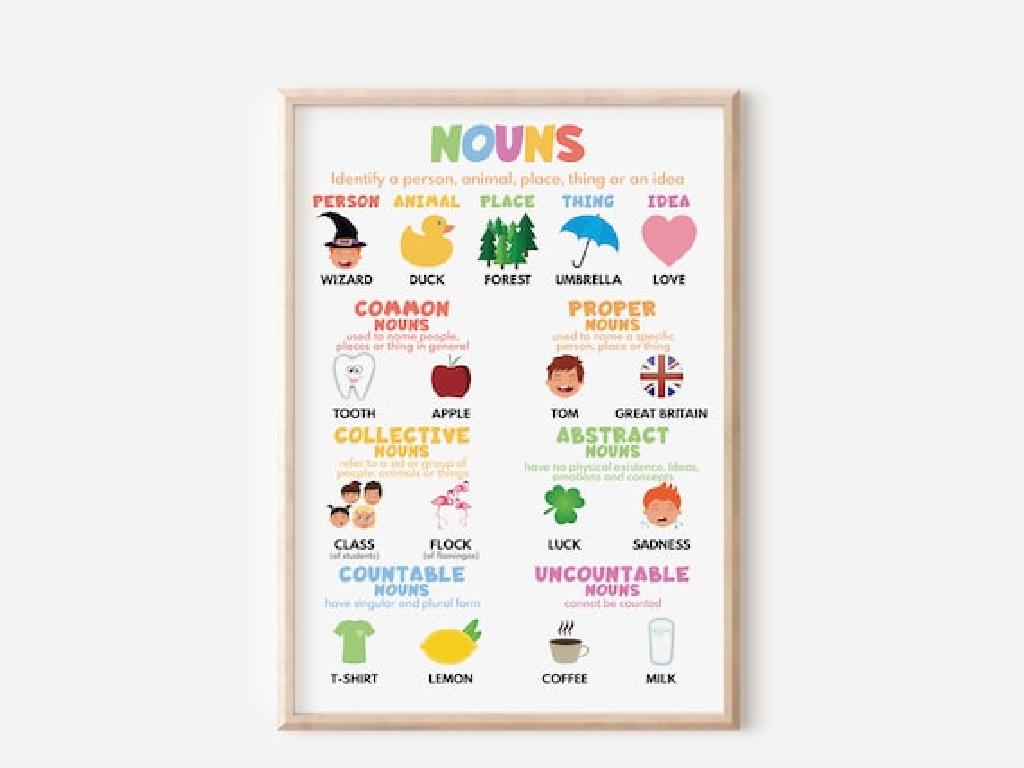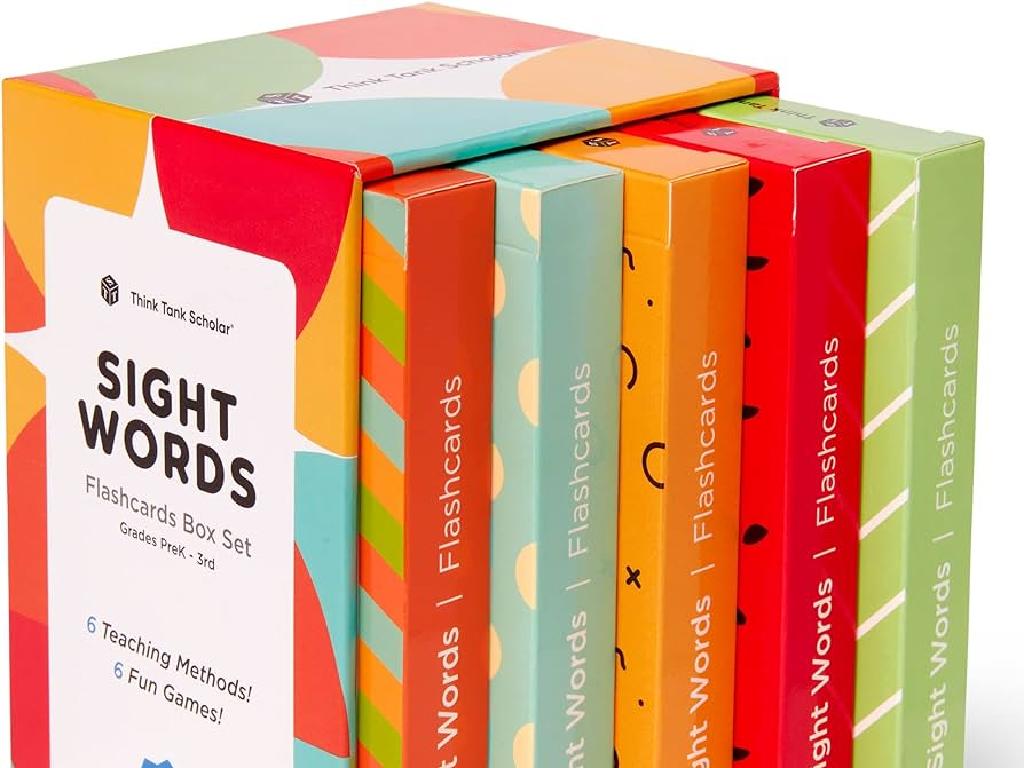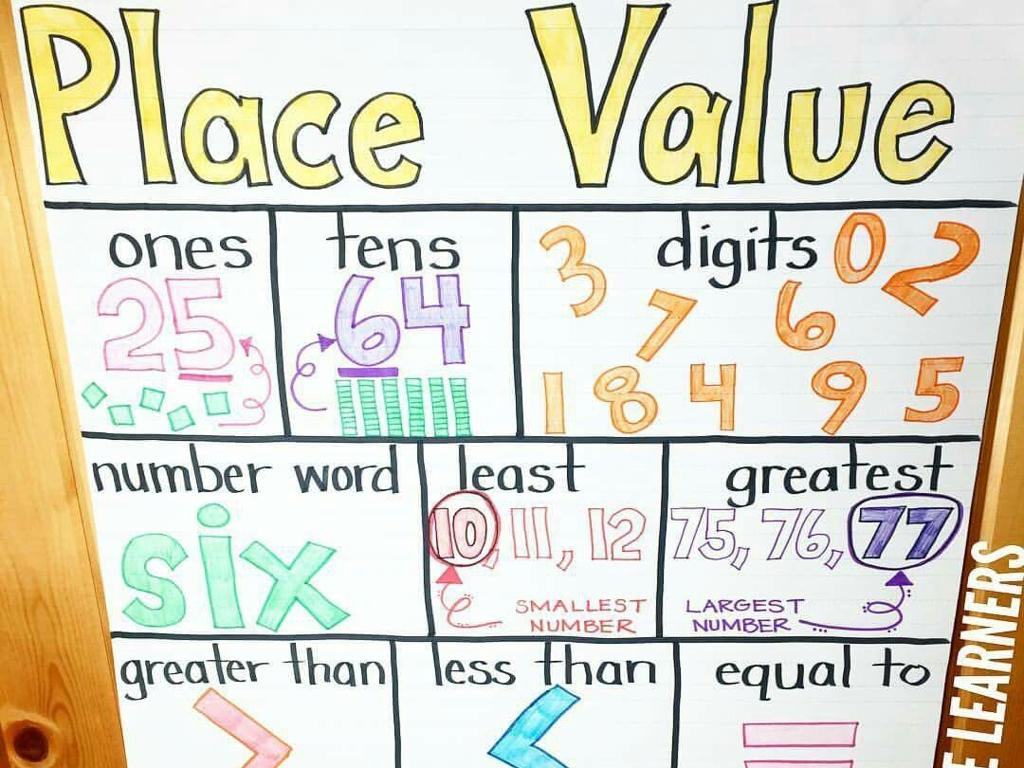Identify Plurals, Singular Possessives, And Plural Possessives
Subject: Language arts
Grade: Fourth grade
Topic: Nouns
Please LOG IN to download the presentation. Access is available to registered users only.
View More Content
Welcome to Nouns!
– Introduction to nouns
– Nouns: Person, Place, Thing, Idea
– Examples: ‘teacher’ (person), ‘school’ (place), ‘book’ (thing), ‘happiness’ (idea)
– Identify classroom nouns
– Look around and find nouns like ‘desk’, ‘board’, ‘friend’
– Engage with noun examples
– Use items in the room to make learning interactive
|
Begin the class with a warm welcome and introduce the topic of nouns, ensuring to create an engaging and inclusive environment. Explain that nouns are words that name people, places, things, or ideas, providing clear examples for each category. Encourage the students to look around the classroom and identify nouns they see, which will help them connect the concept to their immediate surroundings. This activity not only reinforces the definition of nouns but also serves as an icebreaker to get students comfortable with participating. As they identify nouns, write them on the board to visually reinforce the lesson. This interactive approach will help students better understand and remember the concept of nouns.
Singular and Plural Nouns
– What are singular nouns?
– A singular noun names one person, place, or thing.
– What are plural nouns?
– A plural noun names more than one person, place, or thing.
– Changing singular to plural
– Add ‘s’ or ‘es’ to most singular nouns to make them plural.
– Practice with examples
– Let’s turn ‘cat’ into ‘cats’ and ‘bus’ into ‘buses’.
|
This slide introduces the concept of singular and plural nouns to the students. Start by defining singular nouns as words that represent one single item, such as ‘dog’, ‘school’, or ‘child’. Then, explain that plural nouns are used to talk about more than one of something, like ‘dogs’, ‘schools’, or ‘children’. Use visual aids or objects in the classroom to show the difference between singular and plural. Engage the students by asking them to convert singular nouns to plural forms, reinforcing the rules such as adding ‘s’ or ‘es’. Provide a list of nouns for the students to practice with and correct as a class. This activity will help solidify their understanding of the number in nouns.
Making Nouns Plural
– General rule: Add ‘s’ for plurals
– Most nouns become plural by adding ‘s’: cat -> cats, dog -> dogs
– Exceptions: Add ‘es’ for some nouns
– Nouns ending in s, x, z, ch, sh need ‘es’: bus -> buses, box -> boxes
– Examples of plural nouns
– cat -> cats, bus -> buses, fox -> foxes
– Class practice activity
|
This slide introduces the concept of plural nouns to the class. Start by explaining the basic rule of adding ‘s’ to a singular noun to make it plural. Then, discuss the exceptions to this rule, such as when a noun ends in s, x, z, ch, or sh, and in these cases, ‘es’ is added instead. Provide clear examples for both rules to ensure understanding. Engage the class with a practice activity where they can apply these rules by converting singular nouns to their plural forms. This activity can be done individually or in small groups to encourage collaboration.
Singular Possessive Nouns
– What are singular possessive nouns?
– A noun that shows something belongs to one person or thing.
– Adding apostrophe + ‘s’
– To show ownership, add an apostrophe and ‘s’ to a singular noun.
– Practice with examples
– For example, the dog’s leash, the teacher’s book.
– Create your own examples
– Try making a possessive noun from ‘cat’, ‘mom’, or ‘teacher’.
|
This slide introduces the concept of singular possessive nouns to the students, explaining that they are used to show ownership by one person or thing. Emphasize the use of an apostrophe and ‘s’ to make a noun possessive. Provide clear examples on the slide, such as ‘the dog’s leash’ to show the leash belongs to the dog, or ‘the teacher’s book’ to indicate the book belongs to the teacher. Encourage students to practice by creating their own examples using common nouns they are familiar with. This activity will help solidify their understanding of how to form and use singular possessive nouns in writing.
Plural Possessive Nouns
– What are plural possessive nouns?
– A noun that belongs to more than one person or thing.
– Apostrophes show possession
– For words ending in ‘s’, just add an apostrophe.
– Examples of plural possessive nouns
– The puppies’ toys, the teachers’ lounge, the students’ desks.
– Let’s create our own examples!
|
This slide introduces the concept of plural possessive nouns to the class. Begin by explaining that a plural possessive noun shows that something belongs to more than one person or thing. Emphasize the use of an apostrophe after the ‘s’ in plural nouns to indicate possession. Provide clear examples, such as ‘the puppies’ toys’ where the toys belong to more than one puppy, or ‘the teachers’ lounge’ indicating a lounge for all teachers. After explaining, engage the class by asking them to come up with their own examples of plural possessive nouns, possibly using items in the classroom or their own belongings. This activity will help solidify their understanding of how to form and use plural possessive nouns.
Let’s Practice Nouns!
– Review noun forms
– Singular, plural, singular possessive, plural possessive
– Complete the worksheet
– Interactive worksheet or quiz on noun forms
– Discuss answers with peers
– Share your answers, learn from each other
– Peer correction exercise
– Help correct each other’s work kindly
|
This slide is designed for an interactive class activity to reinforce the concept of different noun forms. Begin by reviewing singular, plural, singular possessive, and plural possessive nouns. Distribute a worksheet or quiz for students to complete, which will help them apply what they’ve learned. After completing the worksheet, students should pair up or form small groups to discuss their answers, providing an opportunity for peer learning. Finally, conduct a peer correction exercise where students can gently correct each other’s work, fostering a collaborative learning environment. As a teacher, facilitate the discussion, provide guidance, and ensure a positive atmosphere where students feel comfortable sharing and learning from mistakes.
Class Activity: Possessive Noun Hunt
– Pair up for a noun hunt in class
– Find items and write possessive forms
– For example, ‘desk’ becomes ‘desk’s’ and ‘desks’ becomes ‘desks’
– Share findings with the class
– Review and clarify any mistakes
– Focus on correcting errors like ‘desks’s’ instead of ‘desks’
|
This activity is designed to help students understand and apply the concept of singular and plural possessives in a fun and interactive way. By working in pairs, students will engage with each other and the classroom environment to identify common items and convert their names into possessive forms. After writing down the singular and plural possessive forms of the items they find, each pair will present their list to the class, fostering a collaborative learning experience. As a teacher, listen to the students’ findings, correct any common mistakes, and clarify doubts. This will reinforce the lesson and ensure that students grasp the difference between singular and plural possessives. Possible items for the hunt could include teacher’s desk, students’ chairs, room’s door, or walls’ color.
Wrapping Up: Nouns and Possessives
– Recap: Types of nouns
– Homework: Craft 10 varied sentences
– Include singular, plural, singular possessive, and plural possessive nouns.
– Use singular, plural, and possessive forms
– Show ownership with possessives, e.g., ‘The cat’s toy’ vs. ‘The cats’ toy’.
– Next class: Dive into pronouns!
|
As we conclude today’s lesson, ensure that students have a clear understanding of the different types of nouns discussed: singular, plural, singular possessive, and plural possessive. For homework, they should write 10 sentences that incorporate a mix of these nouns to demonstrate their understanding. This exercise will help reinforce their ability to distinguish between the types and use them correctly. In the next class, we will begin exploring pronouns, which will build on their knowledge of nouns. Encourage students to bring any questions they have to the next class for clarification.






